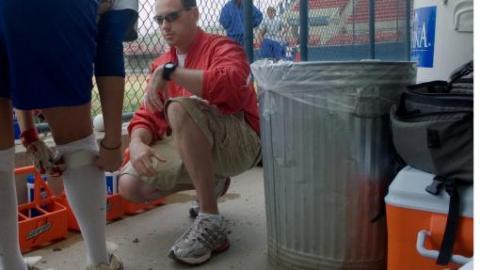
By John Doherty, ATC, PT
As the World Series comes to an anonymous end (No Yankees, no Red Sox, no Cardinals, no Dodgers, and no Cubs means nobody is watching.), here is a tip for all those dads who hope their sons are good enough someday to play in the Fall Classic: The season is over for the pros and it should be for your sons, too.
Let them move on to something else for the winter: basketball, diving (not swimming), hockey, strength training or anything that doesn’t involve throwing. Because the more your sons pitch now, the less likely – not more likely – it is that they will throw at the MLB level later.
There is ample evidence that suggests year-round young pitchers are likely to destroy their elbows. But if that isn’t enough to convince you, here comes a long-term study published in this month’s issue of Radiology. It reveals a previously undocumented condition discovered thanks to the ability of magnetic resonance imaging (MRI) that allows us to see what x-ray and even CT scan cannot.
The condition starts in high school, among pitchers who throw more than 100 pitches per week. That volume of throwing often leads to pain and swelling in the acromio-clavicular (AC) joint of the shoulder. With rest, the pain and swelling go away in three months. But ultimately, 86 percent of those pitchers who experienced AC pain & swelling ended up with incomplete development of one of the bones that make up the joint, specifically the acromion process of the scapula (shoulder blade).
Identified by the researchers as “Os Acromiale,” the condition significantly increases the chance of tearing the rotator cuff, too. More than two-thirds of those with the AC trouble eventually tore the cuff by age 29 but just over one-quarter without the condition ever suffered the same injury. This highlights the importance of watching pitch counts in younger pitchers, specifically those with open growth plates.
Maximum pitch counts have been mandatory in Little League Baseball since 2007. Back when the rule was new, adherence seemed to be high.
Recently, researchers at Case Western Reserve University, one with a son playing Little League, started to wonder if the rule was always being followed. Consequently, they surveyed Little League baseball managers in the Cleveland area. They presented the results of their survey earlier this month at the American Academy of Pediatrics annual conference – this year in San Diego.
While 100 percent of the coaches who responded to the survey were “aware of the need for pitch counts,” only 44 percent always followed the rule. Reasons for non-compliance included lack of assistant coaches and resentment over players also playing for “travel” teams not required to count pitches. Nearly two-thirds of the coaches were “able to identify risk factors for overuse injuries.” Unsurprisingly, more than one-third of the coaches had at least one player “sidelined with an overuse injury” at the time the survey was completed.
These numbers should make Little League administrators take notice both locally and nationally, in Williamsport, Pennsylvania. Parents, too. Whether their sons are Little Leaguers or high schoolers, there is no rule against them counting pitches.
John Doherty, ATC, PT, is a certified athletic trainer and physical therapist, as well as NATA Now’s newest contributor. This column reflects solely his opinion. Reach him at jdoherty@comhs.org or on Twitter at @JDohertyATCPT. You can also view the full version of the article on the Times website.
Posted by NATA News Managing Editor Jaimie Siegle (jaimies@nata.org)
Photo via NATA




